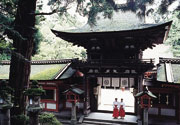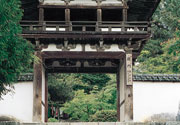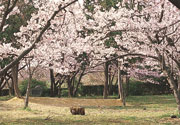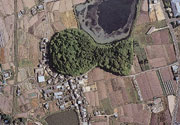 |
 |
| An ancient shrine
in which a divine sword is enshrined |
|
 |
 The
object of warship is a divine sword called "Futsunomitama
no Okami". Old records say the shrine dates back to the 7th
to 8th century, when a powerful clan, the Mononobe, had military
control over the area and the shrine was used to store weapons.
Its main hall of worship dates from the 12th century, and
is one of the oldest examples of shrine architecture in Japan.
The ancient artifacts and treasures excavated in the shrine
grounds are enshrined in its main hall. The
object of warship is a divine sword called "Futsunomitama
no Okami". Old records say the shrine dates back to the 7th
to 8th century, when a powerful clan, the Mononobe, had military
control over the area and the shrine was used to store weapons.
Its main hall of worship dates from the 12th century, and
is one of the oldest examples of shrine architecture in Japan.
The ancient artifacts and treasures excavated in the shrine
grounds are enshrined in its main hall.
 0743-62-0900
/ Open 7 days a week 0743-62-0900
/ Open 7 days a week
 Admission
free (Shrine treasures and accessories are not open to the
public) Admission
free (Shrine treasures and accessories are not open to the
public)
 Take
bus No. 20, 24 or 28 from JR or Kintetsu Tenri Station and
get off at Ishinokami Jingu Mae. A 5-minute walk from the
bus stop / A 30-minute walk from JR or Kintetsu Tenri Station Take
bus No. 20, 24 or 28 from JR or Kintetsu Tenri Station and
get off at Ishinokami Jingu Mae. A 5-minute walk from the
bus stop / A 30-minute walk from JR or Kintetsu Tenri Station |
 |
| The oldest Buddhist
statue in Japan with gems inset in its eyes |
|
 |
 It
is said that this temple was established in 824 A.D. by Kobodaishi,
the founding priest of the Shingon Sect Buddhism. In the main
hall are the "Amidabutsu," the main Buddha in Buddhism, and
two other Buddhist statues to protect it. The three statues,
all of which have crystal eyes, are Japan's oldest Buddhist
images of this kind and are designated as important cultural
assets. In May, the beautiful Hirado Tsusuji (azaleas) in
the grounds are in full bloom. Visitors also have the chance
to taste locally produced Miwa Somen noodles in the kitchen. It
is said that this temple was established in 824 A.D. by Kobodaishi,
the founding priest of the Shingon Sect Buddhism. In the main
hall are the "Amidabutsu," the main Buddha in Buddhism, and
two other Buddhist statues to protect it. The three statues,
all of which have crystal eyes, are Japan's oldest Buddhist
images of this kind and are designated as important cultural
assets. In May, the beautiful Hirado Tsusuji (azaleas) in
the grounds are in full bloom. Visitors also have the chance
to taste locally produced Miwa Somen noodles in the kitchen.
 0743-66-1051
/ 10:00 - 17:00 / Open 7 days a week 0743-66-1051
/ 10:00 - 17:00 / Open 7 days a week
  300 300
 Take
bus No. 60 or 62 from JR or Kintetsu Tenri Station and get
off at Kaminagaoka Chogakuji Mae. A 10-minute walk from the
bus stop / A 20-minute walk from JR Yanagimoto Station Take
bus No. 60 or 62 from JR or Kintetsu Tenri Station and get
off at Kaminagaoka Chogakuji Mae. A 10-minute walk from the
bus stop / A 20-minute walk from JR Yanagimoto Station |
 |
| The origin of Sumo
wrestling |
|
 |
 Sumo
wrestling is the national martial art of Japan, in which wrestlers
compete for superiority in power and technique. It is said
that Sumo Shrine is the place where sumo first began, and
it is here, according to records, that Nominosukune and Taimanokehaya
competed before the 11th Emperor, Suijin. The winner of the
competition, Nominosukune, is enshrined in a small shrine
in the sanctuary. We can still see the remains of the sumo
ring where that competition took place. Sumo
wrestling is the national martial art of Japan, in which wrestlers
compete for superiority in power and technique. It is said
that Sumo Shrine is the place where sumo first began, and
it is here, according to records, that Nominosukune and Taimanokehaya
competed before the 11th Emperor, Suijin. The winner of the
competition, Nominosukune, is enshrined in a small shrine
in the sanctuary. We can still see the remains of the sumo
ring where that competition took place.
 0744-42-9111
(Sakurai City Tourist Association) 0744-42-9111
(Sakurai City Tourist Association)
 Admission
Free Admission
Free
 Take
bus No. 60 or 62 from JR or Kintetsu Sakurai Station and get
off at Sumo Jinja Guchi. A 20-minute walk from the bus stop Take
bus No. 60 or 62 from JR or Kintetsu Sakurai Station and get
off at Sumo Jinja Guchi. A 20-minute walk from the bus stop |
 |
| One of the oldest
tombs in Yamato (Nara Prefecture) |
|
 |
 A
large keyhole-shaped tomb mound, 272m in length, that was,
according to "Nihonshoki", the Chronicles of Japan, a collaboration
between humans and the gods - the former worked during the
day and the latter at night. It is said that a noble princess
was buried here. The princess married "Ohmononushi", the deity
of Mt. Miwa. One day the princess learned that her husband
was a snake and screamed aloud in surprise. Her husband, the
deity, returned to Mt. Miwa, and the princess was so distraught
she killed her private parts by stabbing herself with chopsticks
(hashi). This is how Hashihaka (the Chopstick Tomb) was named. A
large keyhole-shaped tomb mound, 272m in length, that was,
according to "Nihonshoki", the Chronicles of Japan, a collaboration
between humans and the gods - the former worked during the
day and the latter at night. It is said that a noble princess
was buried here. The princess married "Ohmononushi", the deity
of Mt. Miwa. One day the princess learned that her husband
was a snake and screamed aloud in surprise. Her husband, the
deity, returned to Mt. Miwa, and the princess was so distraught
she killed her private parts by stabbing herself with chopsticks
(hashi). This is how Hashihaka (the Chopstick Tomb) was named.
 0744-42-9111
: Shoko-Kanko-Ka (the Commerce and Tourism Divn., Sakurai
City) 0744-42-9111
: Shoko-Kanko-Ka (the Commerce and Tourism Divn., Sakurai
City)
 Admission
free Admission
free
 Take
bus No. 60 and 62 from JR or Kintetsu Sakurai Station and
get off at Hashinaka. A 5-minute walk from the bus stop on
foot / A 10-minute walk from JR Makimuku Station Take
bus No. 60 and 62 from JR or Kintetsu Sakurai Station and
get off at Hashinaka. A 5-minute walk from the bus stop on
foot / A 10-minute walk from JR Makimuku Station |
|

